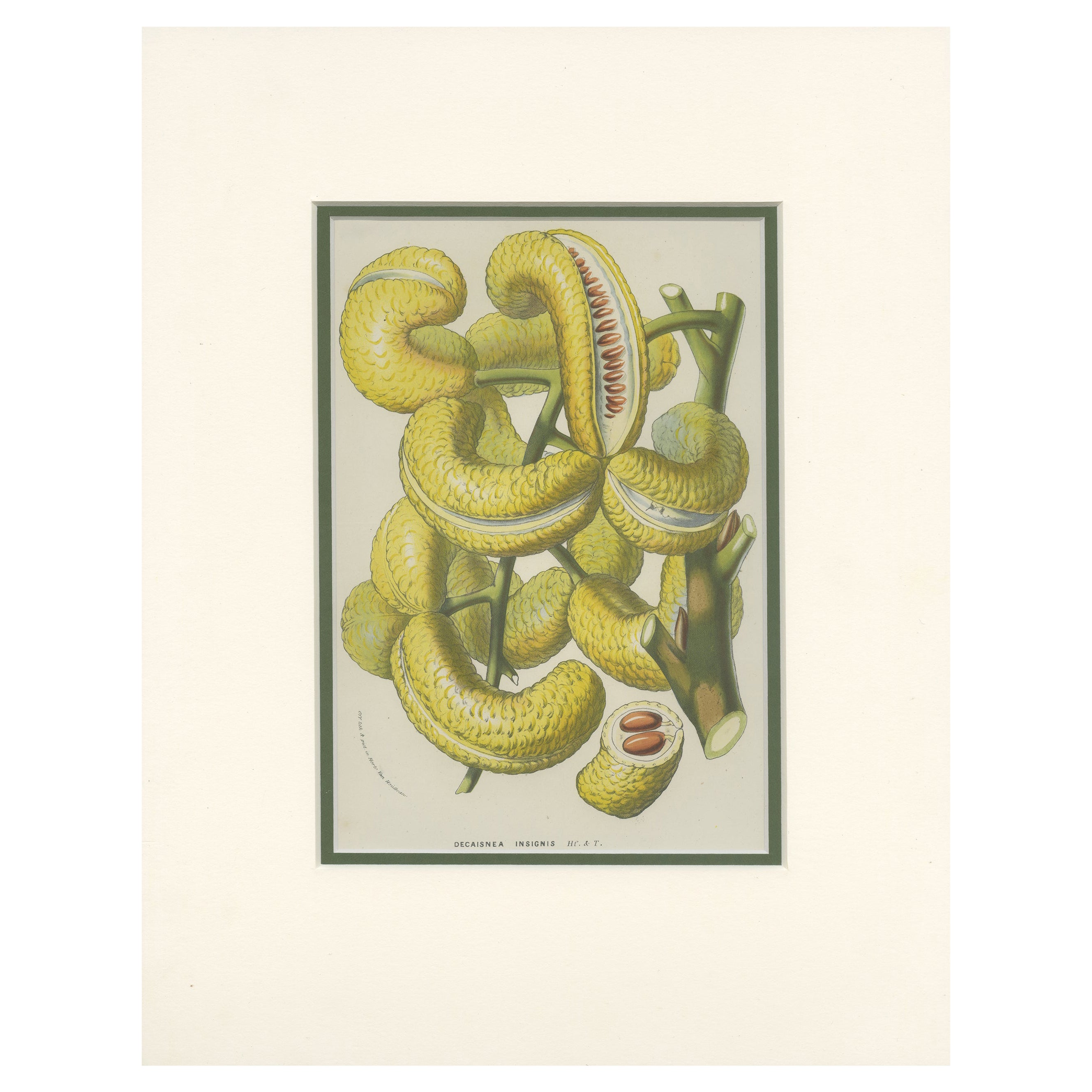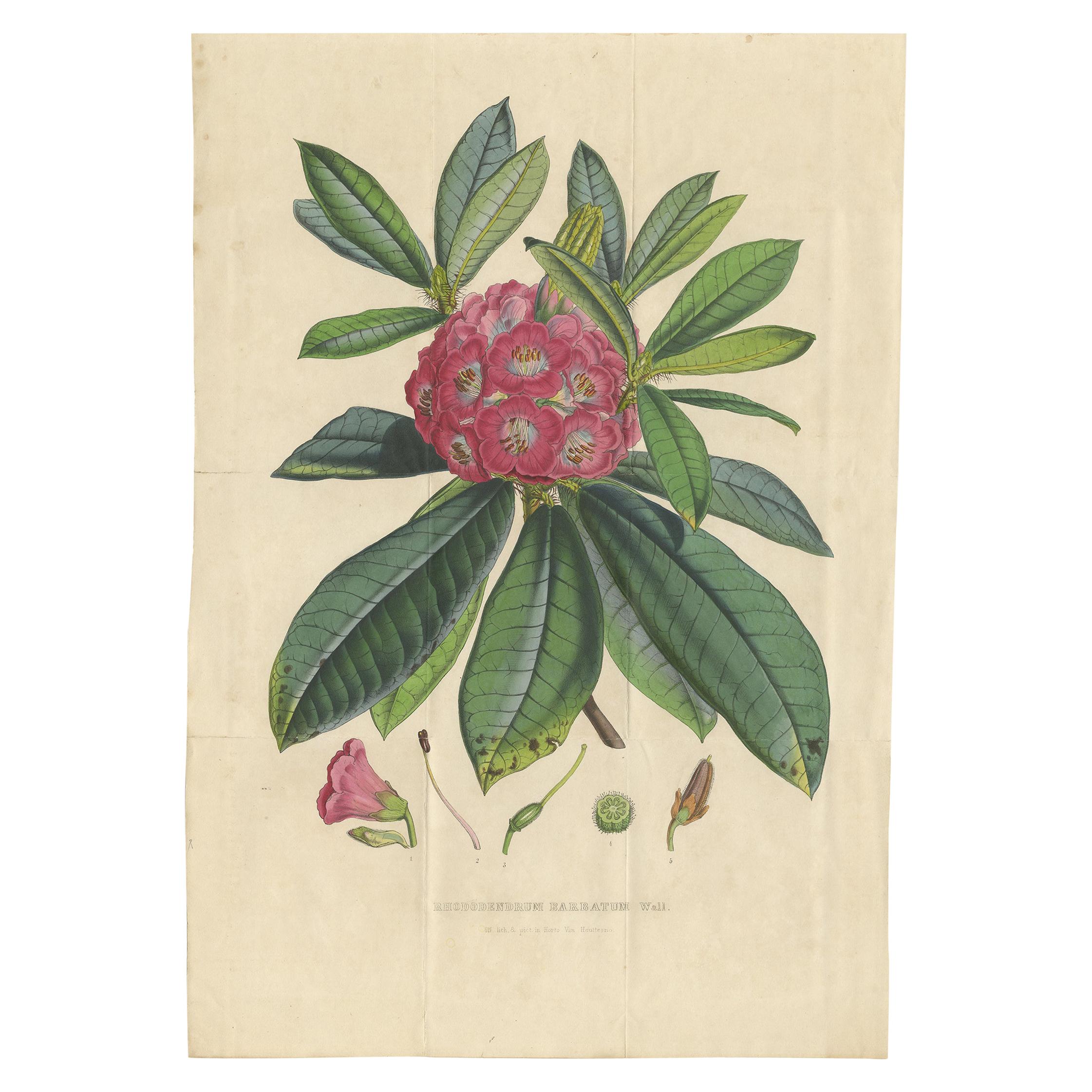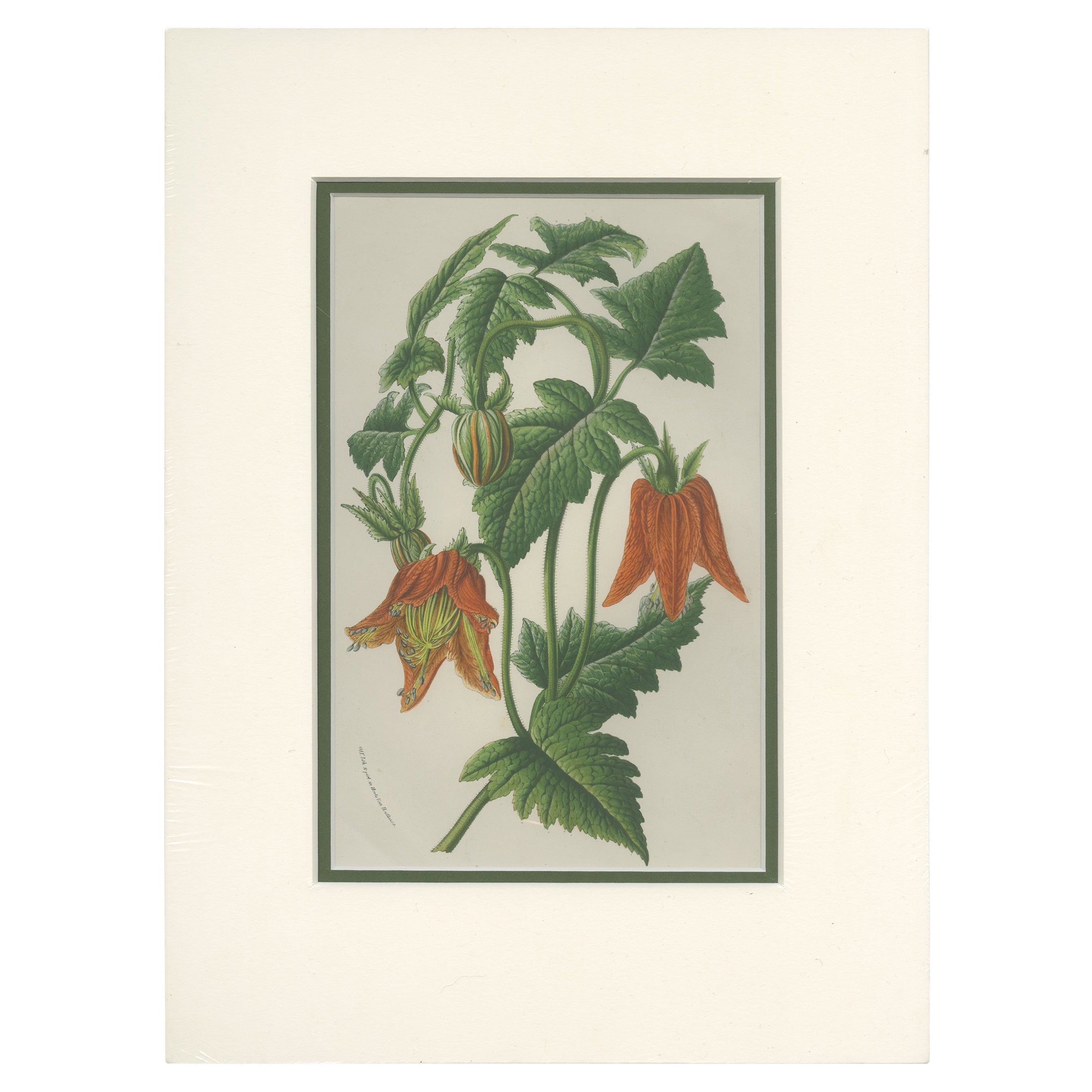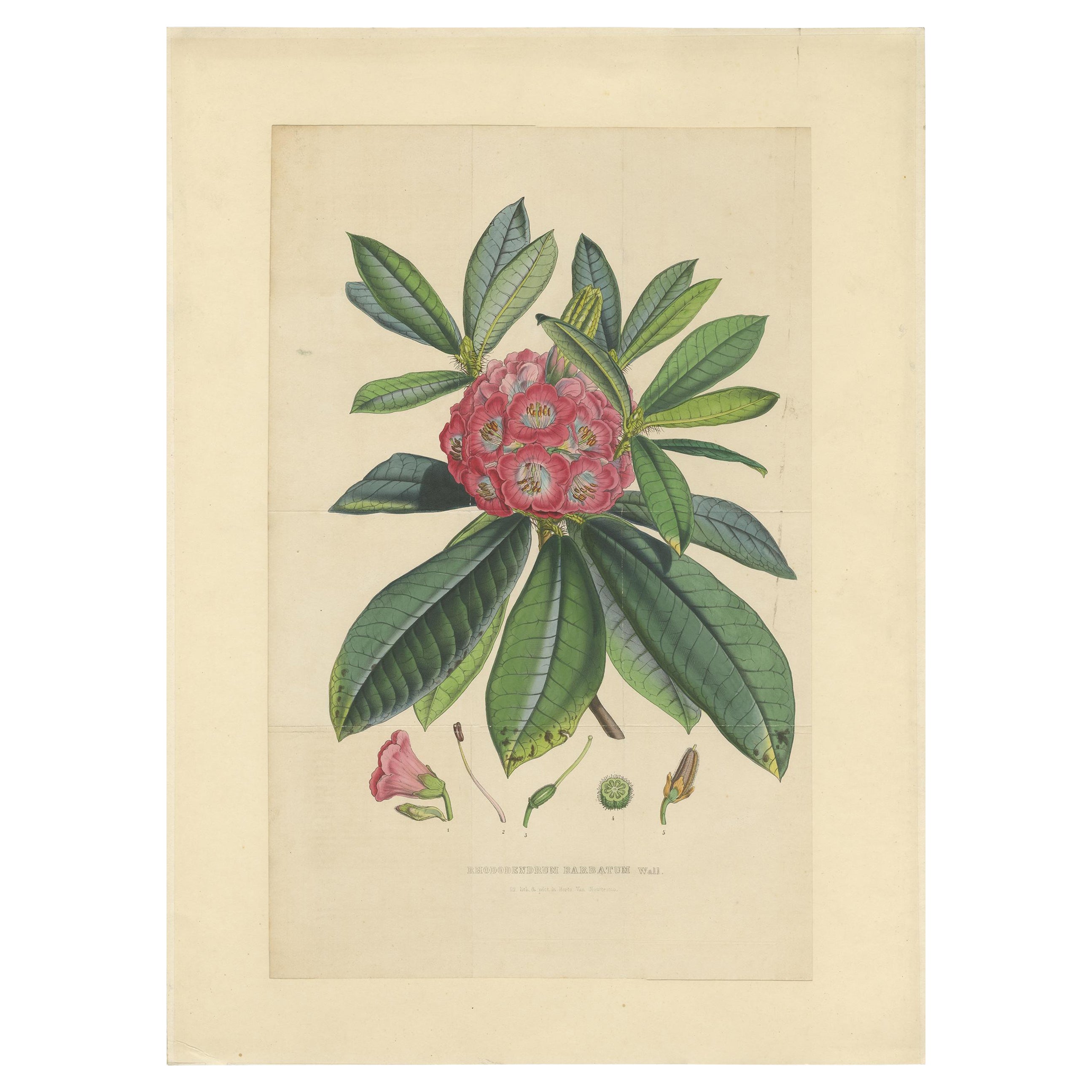Items Similar to Botanical Print of The Californian Sunflower, Louis van Houtte
Want more images or videos?
Request additional images or videos from the seller
1 of 5
Botanical Print of The Californian Sunflower, Louis van Houtte
About the Item
Botanical Print of Helianthus Californicus Insignis,
The Californian Sunflower,
Flore des serres et des jardins de l'Europe,
Louis van Houtte. (1810-1876)
The framed print depicts the Californian sunflower. The flower is large and completely fills the space.
Dimensions: 21 1/4 inches high x 17 3/4 inches wide x 1 1/2 inches deep
Reference:
Helianthus Californicus Insignis -
The California sunflower is native to California and Baja California, where it will grow in many different types of habitat. This wild sunflower is an erect perennial growing from a network of tough woody roots with small rhizomes. It is a sprawling, gangly plant sending up a thin stem towards the sun to a height of 3 to 10 feet. This painting by Huatte was for his epic botanical journals The Flowers of the Greenhouses and Gardens of Europe and this picture was in volume 15 which was published around 1863, it shows a full head of the sunflower with ripe seeds.
Louis van Houtte
(From Wikipedia, the free encyclopedia)
Louis Benoît van Houtte (29 June 1810 Ypres - 9 May 1876 Ghent) was a Belgian horticulturist who was with the Jardin Botanique de Brussels between 1836 and 1838 and is best known for the journal Flore des Serres et des Jardins de l'Europe, produced with Charles Lemaire and M. Scheidweiler,an extensive work boasting more than 2000 coloured plates in 23 volumes published between 1845 and 1883.
Early in his career van Houtte worked in Brussels for the ministry of finance. All his leisure time was spent on botany at the botanical garden and private estates. He was on good terms with men like Parmentier, Édouard Parthon de Von (1788-1877), D'Enghien, and befriended local gardeners.
Together with Charles François Antoine Morren, van Houtte founded L'Horticulteur Belge (1833-1838), a monthly magazine, in November 1832. The 119 hand-coloured plates that were published are engravings or sometimes lithographs. There are also 78 plates showing delicate engravings of views. This period in Belgium after 1830 is characterised by a close collaboration between nurseries and the foremost botanists, allowing the English stranglehold on horticulture to be broken.
van Houtte also started a shop selling seeds and garden tools. Botany continued to hold his interest, and the tropical plants flooding into Europe provided a wealth of material for study.
Devastated by the loss of his wife to whom he had been married only a short while, he set off to Brazil to collect orchids for Parthon de Von and the Belgian King, while the botanical garden, which was a commercial company by then, would take any new seed he brought back.
He left for Rio de Janeiro on 5 January 1834, but due to bad weather and stopping over at Maio in the Cape Verde islands, only arrived in May 1834. Whilst in Rio, he climbed Corcovado and collected in Jurujuba. Having difficulty in coping with carrying all his equipment, he employed an assistant on a trip to the Organ Mountains.
His next excursion was to Minas Gerais, which he explored for seven months, falling under the spell of the constantly changing scenery between Villa Rica and Ouro Preto. He visited Mato Grosso, Goyaz, São Paulo, and Paraná. He had met an English plant collector John Tweedie in Banda Oriental and they made a number of trips together.
When he returned from his 1834-36 expedition to Brazil, van Houtte founded the Ecole d'Horticulture at Ghent and started the horticultural journal Flore des serres et des Jardins de l'Europe, which eventually comprised more than 2 000 coloured plates in 23 volumes published from 1845 to 1883, some volumes being published after his death. Collaborators on the journal were Charles Lemaire and Michael Scheidweiler.
He also established a nursery at Gentbrugge near Ghent with partner Adolf Papeleu. Van Houtte's botanical knowledge, business acumen and facility with languages, led to his commercial success and the office of mayor of Gentbrugge.
At the height of European orchid mania in 1845 he despatched plant collectors to the Americas to search for orchids and other exoticplants. Van Houtte produced plants for European conservatories and with the help of Eduard Ortgies cultivated the first Victoria Lily on the Continent. By the 1870s van Houtte's nursery was flourishing, covering 14 hectares and comprising 50 greenhouses. The business was carried on by van Houtte's son, when he died in 1876.
He created the genus Rogiera Rubiaceae to honour his friend Charles Rogier with whom he had fought in the Belgian Revolution of 1830. This botanist is denoted by the author abbreviation Van Houtte when citing a botanical name.
(Ref: ny7873-nrr)
- Dimensions:Height: 21.25 in (53.98 cm)Width: 17.75 in (45.09 cm)Depth: 1.5 in (3.81 cm)
- Style:Victorian (Of the Period)
- Materials and Techniques:
- Place of Origin:
- Period:
- Date of Manufacture:1860s
- Condition:Wear consistent with age and use.
- Seller Location:Downingtown, PA
- Reference Number:
About the Seller
5.0
Recognized Seller
These prestigious sellers are industry leaders and represent the highest echelon for item quality and design.
Gold Seller
These expertly vetted sellers are highly rated and consistently exceed customer expectations.
Established in 1916
1stDibs seller since 2009
365 sales on 1stDibs
Typical response time: <1 hour
Associations
The Art and Antique Dealers League of AmericaAntiques Associations Members
- ShippingRetrieving quote...Ships From: Downingtown, PA
- Return PolicyA return for this item may be initiated within 3 days of delivery.
More From This SellerView All
- Botanical Large Print After Joseph Nigg, from the Ateliers Lithographiques MourlBy Joseph NiggLocated in Downingtown, PABotanical Print after the painting of the Austrian painter, Joseph Nigg, (1782-1863) Artist: Joseph Nigg (1782-1863) Medium: Lithograph Dimensions: 39 3/4 inches high x 31 i...Category
Vintage 1940s Georgian Prints
MaterialsPaper
- 17th-Century Botanical Engravings of Mosses and Ferns By John ParkinsonBy John ParkinsonLocated in Downingtown, PAJohn Parkinson was the last of the great English herbalists and one of the first of the great English botanists. Here the pair of prints show mosses and lichen and the other of ferns. From: Paradisi in sole Paradisus Terrestris: or a garden of all sorts of pleasant flowers...Category
Antique 1620s English Jacobean Prints
MaterialsPaper
- George Brookshaw Print of Four Varieties of Plums, Plate XVII, Dated 1806By George BrookshawLocated in Downingtown, PAGeorge Brookshaw print of four varieties of plums, Plate XVII, from Natural History Art, Botanical, Fruit, Brookshaw, Pomona Britannica, 1806 ...Category
Antique Early 19th Century English Georgian Prints
MaterialsPaper
- Johann Wilhelm Weinmann Print of Roses with Decoupage FrameBy Johann Wilhelm WeinmannLocated in Downingtown, PAJohann Wilhelm Weinmann print of roses with decoupage frame, Engraved by Johann Jacob Haid, From Phytanthoza Iconographia, Circa 1737-1745 The ...Category
Antique Mid-18th Century German Georgian Prints
MaterialsPaper
- George Brookshaw Print of Two Varieties of Raspberries, One Yellow and One RedBy George BrookshawLocated in Downingtown, PAGeorge Brookshaw print of two varieties of raspberries, one yellow and one red. Plate IV, from Natural History Art, Botanical, Fruit, Brookshaw, Po...Category
Antique Early 19th Century English Georgian Prints
MaterialsPaper
- George Brookshaw Print of Pears from Pomona Britannica, Dated 1807By George BrookshawLocated in Downingtown, PAGeorge Brookshaw Print of Pears from Natural History Art, Botanical, Fruit, Brookshaw, Pomona Britannica, Plate LXXXV, Dated 1807 The publ...Category
Antique Early 19th Century English Georgian Decorative Art
MaterialsPaper
You May Also Like
- Antique Botany Print of the Decaisnea by Van Houtte 'c.1845'Located in Langweer, NLAntique botany print titled 'Decaisnea Insignis'. Original antique print of the Decaisnea, known commonly as dead man's fingers, blue bean plant or blue sausage fruit. This print originates from 'Flore des Serres' by Louis van Houtte...Category
Antique Mid-19th Century Prints
MaterialsPaper
- Set of 2 Antique Botany Prints, Rhododendron, by Louis van Houtte, 1849Located in Langweer, NLSet of two antique botany prints titled 'Rhododendrum Falconeri' and 'Rhododendrum Argenteum'. It depicts the falconer rhododendron and rhododendron Grande. These prints originate from volume 5 of 'Flore des serres et des jardins de l'Europe' by Louis van Houtte.Category
Antique Mid-19th Century Prints
MaterialsPaper
- Antique Botany Print of the Rhododendron Barbatum by Van Houtte, 1849Located in Langweer, NLAntique botany print titled 'Rhododendrum Barbatum'. Large lithograph of the rhododendron barbatum. This print originates from volume 5 of 'Flore des serres et des jardins...Category
Antique Mid-19th Century Prints
MaterialsPaper
- Antique Botany Print of the Illairea Canarinoides by Van Houtte 'c.1845'Located in Langweer, NLAntique botany print titled 'Illairea Canarinoides'. Original antique print of the Illairea Canarinoides. This print originates from 'Flore des Serres' by Louis van Houtte...Category
Antique Mid-19th Century Prints
MaterialsPaper
- Antique Botany Print of the Gustavia Insignis by Van Houtte 'c.1845'Located in Langweer, NLAntique botany print titled 'Gustavia Insignis'. Original antique print of the Gustavia Insignis. This print originates from 'Flore des Serres' by Louis van Houtte...Category
Antique Mid-19th Century Prints
MaterialsPaper
- Antique Botany Print of The Rhododendron Barbatum by Van Houtte, 1849Located in Langweer, NLAntique botany print titled 'Rhododendrum Barbatum'. Large lithograph of the rhododendron barbatum. This print originates from volume 5 of 'Flore des serres et des jardins de l'Europ...Category
Antique 19th Century Prints
MaterialsPaper





